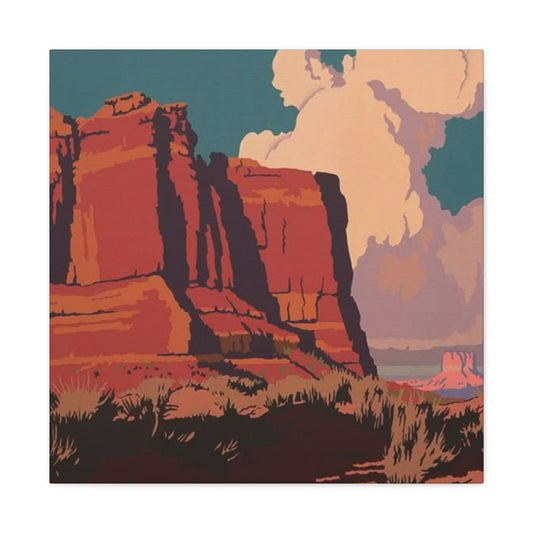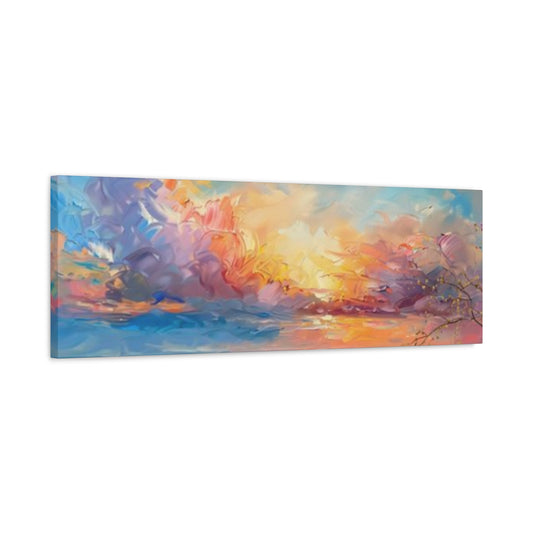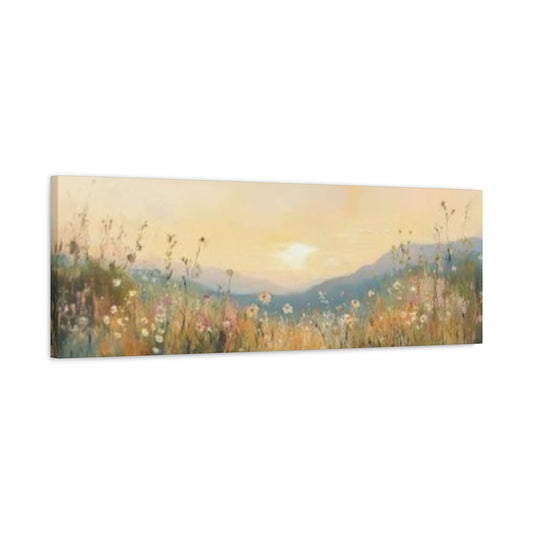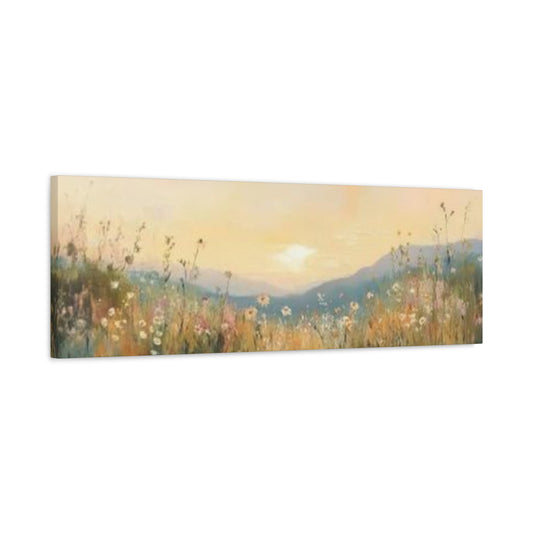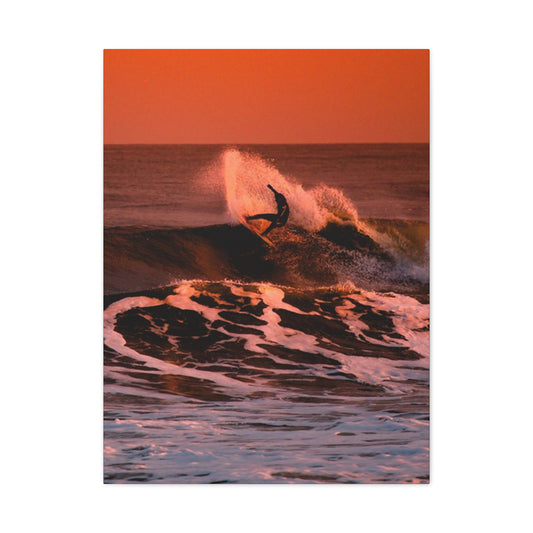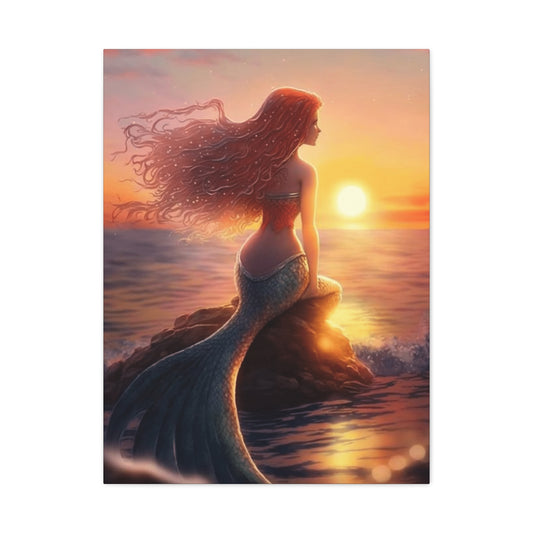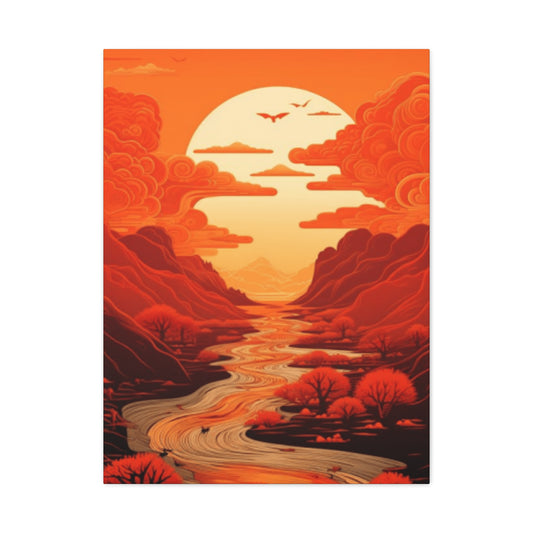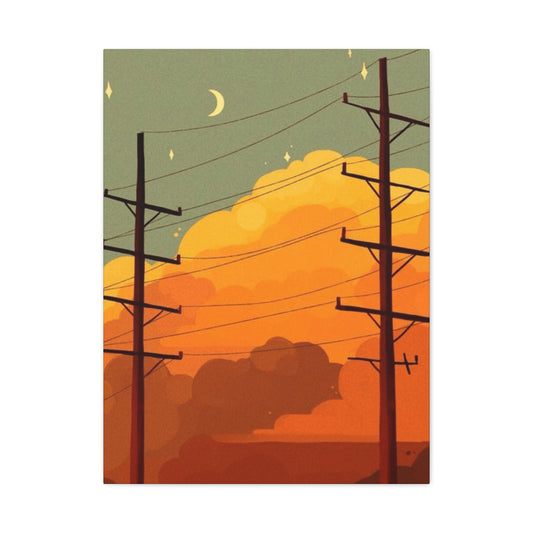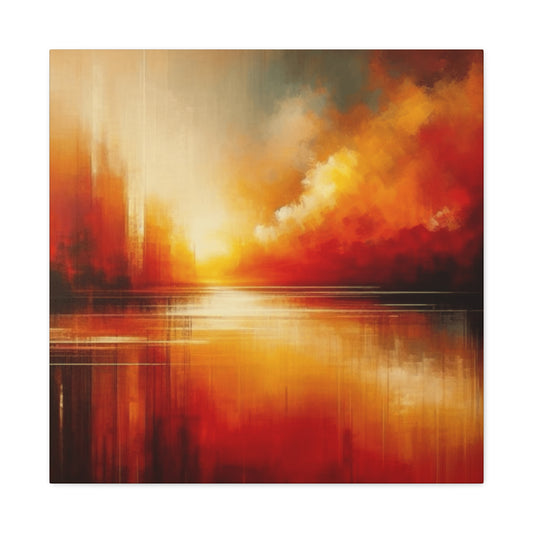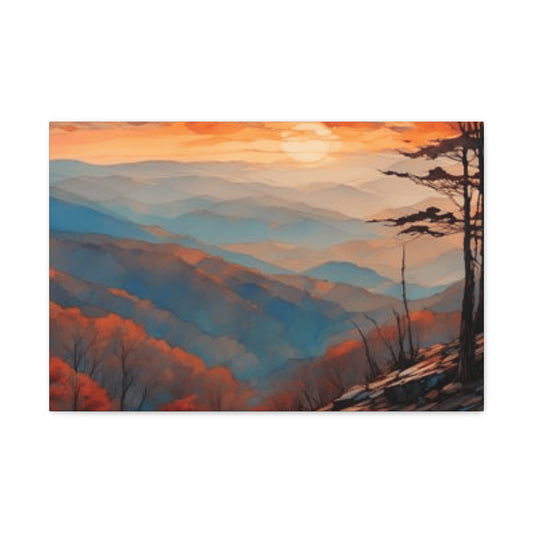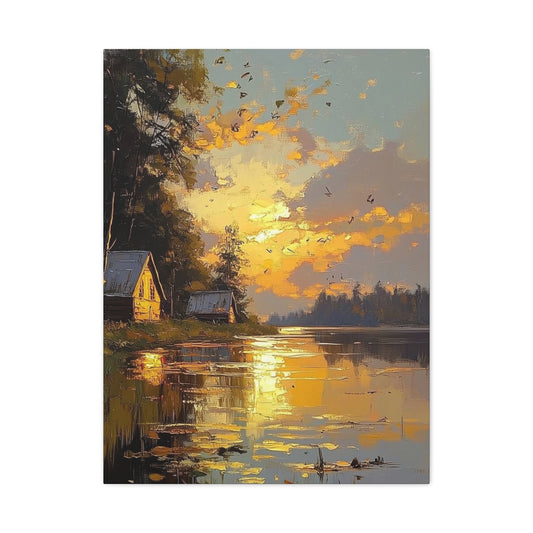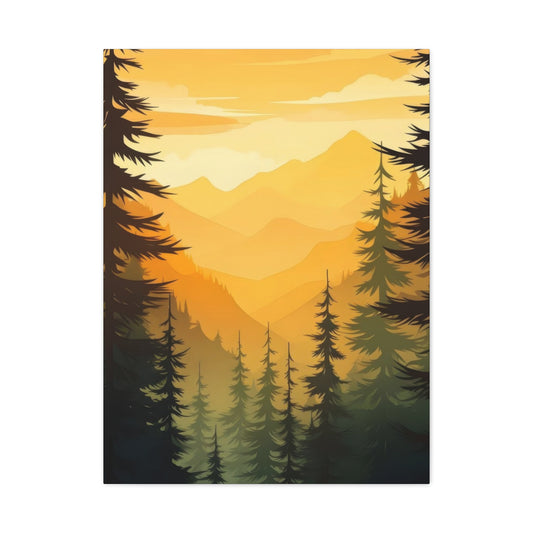Colors of Twilight: Celebrating Sunset Wall Art
Sunsets have always captivated human imagination. From the earliest cave paintings to the masterpieces of the Renaissance and modern art, the sky at dusk has served as a source of inspiration for countless artists. There is something universally appealing about the moment when the sun descends, casting its final warm light across the horizon. This natural spectacle evokes feelings of calm, wonder, and introspection. The allure of sunset paintings lies not only in the visual beauty of the scene but also in the emotions and memories they can stir in viewers. For artists, sunsets provide an ever-changing canvas that challenges them to capture the delicate balance of light and color while conveying a sense of mood and atmosphere.
Observing the Natural World
As an artist, my fascination with sunset paintings began with careful observation of the natural world. Growing up in Texas, I was fortunate to witness countless sunsets that varied in intensity, hue, and atmosphere. Each evening offered a new composition, with the sky shifting from pale yellows to fiery oranges, and gradually transforming into deep purples and blues. Observing these transitions taught me to notice the subtleties in light and color that define a sunset. It is these nuances that make each painting unique and allow an artist to infuse personal interpretation into the work. Observing sunsets also fosters a deeper appreciation for the natural rhythms of the day and the patterns that occur in the sky, clouds, and landscape.
The Emotional Connection to Sunsets
Sunsets have a way of connecting with human emotions in a profound manner. They often evoke feelings of nostalgia, tranquility, and romance. The fleeting nature of a sunset—its impermanence—reminds us of the transient beauty in life. For many viewers, a sunset painting can rekindle memories of past experiences, travels, or intimate moments shared with loved ones. As an artist, creating sunset paintings is not merely a technical exercise but an emotional endeavor. Each brushstroke carries a fragment of the emotion experienced while observing the scene. Capturing this emotional resonance is as important as achieving color accuracy or compositional balance, as it allows the painting to speak to the viewer on a deeper level.
The Symphony of Colors
One of the most compelling aspects of sunset paintings is the range of colors they offer. The sky at sunset provides a natural palette that spans warm tones of red, orange, and gold, cooler shades of blue and violet, and subtle transitional hues that blend seamlessly into one another. For an artist, this spectrum of colors provides endless possibilities for experimentation and creativity. The interplay between warm and cool tones can create a sense of depth and movement, guiding the viewer’s eye across the canvas. Mastering these color harmonies requires careful study and practice, but when executed successfully, they produce a visually stunning and emotionally evocative piece.
Capturing Light and Shadow
The challenge of sunset paintings extends beyond color selection; it involves capturing the interplay of light and shadow. As the sun lowers on the horizon, it casts long, soft shadows that sculpt the landscape, highlighting textures and shapes that are otherwise unnoticed. The way light reflects off clouds, water, and surfaces adds complexity and drama to a painting. Artists must pay close attention to the intensity, direction, and quality of light to convey a realistic yet expressive depiction of a sunset. Skillful manipulation of light and shadow can transform a simple landscape into a dynamic scene that feels alive, immersive, and emotionally compelling.
Versatility Across Settings
Sunset paintings offer remarkable versatility, allowing artists to explore a wide range of settings and themes. The sunset can be depicted over rolling hills, oceans, forests, urban skylines, or even abstracted skies that emphasize color and form over literal representation. This versatility enables artists to incorporate sunsets into various compositions, whether the focus is on natural landscapes, seascapes, or imaginative creations. Each setting presents unique challenges and opportunities, requiring adjustments in perspective, composition, and tonal balance. By experimenting with different environments, artists can expand their creative repertoire and explore new ways of expressing the beauty of the evening sky.
Drama and Movement in the Sky
The sky during sunset is rarely static; it is a dynamic space filled with movement and energy. Clouds shift and scatter light, creating dramatic contrasts and fleeting patterns that change minute by minute. For a painter, capturing this sense of movement is essential to conveying the life and vitality of the scene. Techniques such as layering, glazing, and varied brushwork can simulate the flow and texture of clouds, the shimmer of light, and the gradual transition of colors. Successfully portraying drama in the sky not only enhances visual interest but also invites viewers to linger, as their eyes trace the subtleties and rhythms of the composition.
The Personal Significance of Sunsets
Beyond their aesthetic and technical appeal, sunset paintings hold deep personal significance for many artists. They serve as a medium for reflection, expression, and connection to the world around us. Painting sunsets allows artists to slow down and observe nature with heightened awareness, fostering mindfulness and creative contemplation. Each painting becomes a record of a specific moment, a unique interpretation of the interplay between light, color, and atmosphere. For me, this process is both meditative and exhilarating, as it combines the joy of creation with the wonder of observing nature’s fleeting masterpieces.
The Impact on Viewers
Sunset paintings resonate strongly with viewers because they evoke universal experiences and emotions. The imagery of a setting sun is familiar to all, transcending cultural and geographic boundaries. When well-executed, a sunset painting can transport viewers to a place of calm, reflection, or inspiration. The combination of vibrant colors, dramatic lighting, and thoughtful composition engages both the senses and the imagination. As a result, sunset paintings often become treasured works that evoke repeated admiration and contemplation. Artists take pride in the ability to create art that connects with people in such a meaningful way, reinforcing the enduring appeal of sunsets in visual expression.
The Creative Journey
The process of creating a sunset painting is itself a journey of discovery and skill development. It involves observation, planning, experimentation, and refinement. Artists often study the sky at different times of day, experimenting with color mixes and brush techniques to achieve the desired effect. The challenge lies in balancing realism with artistic interpretation, ensuring that the painting communicates both the beauty of the scene and the emotional essence of the moment. Over time, this creative journey deepens an artist’s understanding of light, color, and composition, contributing to overall growth and mastery in the craft.
Sunset Landscapes: Capturing Nature’s Grandeur
Sunset landscapes hold a special allure for both artists and viewers. The gradual fading of light across hills, mountains, forests, and plains creates opportunities to explore the interplay between natural elements and atmospheric conditions. Each sunset presents a new challenge, as no two evenings are exactly alike. Painting landscapes during sunset involves careful observation of light, color, and shadow. The rolling hills, jagged cliffs, or expansive plains provide a natural canvas where the sun’s final rays create depth, texture, and perspective. Artists must balance realism with interpretation, allowing the landscape to communicate a sense of mood, scale, and serenity.
The versatility of landscapes as subjects is vast. From wide, panoramic vistas to intimate forest clearings, the setting sun transforms ordinary terrain into dramatic scenes. Light filtering through trees, reflecting off rivers or lakes, or glancing across mountains imbues the landscape with a magical quality. This natural drama captures attention and allows the artist to convey emotions that extend beyond the visual. Sunset landscapes are particularly effective in evoking feelings of calm, reflection, and wonder, making them enduring favorites in the world of painting.
Seascapes and the Dance of Light
Seascapes are another domain where sunset paintings shine. The interaction between water and sky produces dynamic effects that challenge even seasoned artists. Waves catch the sun’s reflections, creating shimmering patterns of gold, red, and orange. Clouds above the ocean often mirror the colors of the water, while the horizon line separates the infinite sky from the undulating sea. The rhythm and movement of water introduce additional complexity, requiring careful attention to detail, brushwork, and color blending.
Sunset seascapes have a unique emotional resonance. They often symbolize freedom, vastness, and contemplation. The meeting of sky and water at dusk offers a visual metaphor for the convergence of reality and imagination. Artists frequently explore the reflections of light, the subtle shifts in hue, and the dynamic movement of waves to create a sense of fluidity and life. Seascapes during sunset can convey a sense of peace or evoke powerful emotions, depending on the intensity of color and contrast, making them ideal for capturing moments that stir the human spirit.
Urban Sunsets: Cities in the Evening Light
While nature provides endless inspiration, urban environments offer their own unique opportunities for sunset paintings. Cities during dusk are transformed as the sun casts long shadows over buildings, streets, and skylines. Reflections on glass windows, the glow of streetlights, and silhouettes of architecture create a dramatic contrast between natural and artificial elements. Urban sunsets allow artists to experiment with perspectives, angles, and color contrasts in ways that differ from landscapes or seascapes.
Painting cities at sunset involves observing how light interacts with different materials and surfaces. The warm tones of the setting sun soften harsh architectural lines, while shadows stretch across streets and rooftops, emphasizing form and structure. Artists often capture the hustle and calm of city life simultaneously, conveying a narrative through light and color. Urban sunsets also offer a unique perspective on human presence within natural cycles, blending the tranquility of evening skies with the energy of metropolitan life.
Cultural Significance of Sunset Imagery
Throughout history, sunsets have held cultural and symbolic significance across civilizations. In many cultures, sunsets symbolize endings, transitions, and the passage of time. They mark the conclusion of the day, reminding humans of life’s impermanence and the importance of reflection. Artists have long drawn upon these associations, creating works that convey philosophical, spiritual, or emotional messages.
In certain Eastern traditions, sunsets are linked to meditation and mindfulness, emphasizing the beauty of the present moment. In Western art, sunset imagery often represents romance, nostalgia, or sublime beauty. These cultural associations influence both the creation and interpretation of sunset paintings, adding layers of meaning beyond the aesthetic. By understanding the cultural context, artists can imbue their works with symbolic depth, resonating with viewers on intellectual and emotional levels.
Techniques for Painting Sunsets in Different Settings
Creating a compelling sunset painting requires mastery of several techniques tailored to the subject matter. In landscapes, the use of atmospheric perspective helps convey depth, while careful blending of colors can mimic the gradual transition of light across hills, valleys, or trees. In seascapes, artists focus on reflections, wave movement, and the dynamic interaction of light with water. Urban sunsets often demand precision in capturing architectural forms, light reflection, and shadows, while still conveying the warmth and glow of the setting sun.
Color mixing is a critical component of sunset painting. Artists experiment with warm and cool tones to achieve harmony and contrast, often layering glazes or using wet-on-wet techniques to create smooth transitions. Brushwork varies depending on the texture of the subject—soft, sweeping strokes for clouds and sky, sharper lines for buildings and tree branches, and textured patterns for water surfaces. These techniques, combined with observation and interpretation, enable artists to translate the ephemeral beauty of a sunset into a lasting work of art.
Emotional Storytelling Through Sunsets
Sunset paintings often carry narratives beyond the visual. By carefully selecting a setting, composition, and color palette, artists can convey emotions, tell stories, or evoke specific memories. A sunset over a quiet beach might suggest solitude and contemplation, while a bustling city skyline at dusk may reflect energy and movement juxtaposed with serenity. The emotional storytelling inherent in sunset paintings allows viewers to engage deeply with the artwork, creating a personal connection that extends beyond aesthetic appreciation.
Artists also consider the placement of elements within the composition to enhance narrative impact. Clouds, water reflections, and silhouettes can guide the viewer’s gaze and emphasize emotional tone. The contrast between light and shadow, warm and cool colors, and foreground and background elements all contribute to the story the painting tells. This intentional design transforms a simple depiction of the sky into a meaningful experience for the audience.
Capturing the Fleeting Moment
A defining challenge of sunset painting is its temporality. Sunsets change rapidly, and the exact combination of colors, light, and cloud formations exists only for a brief moment. Artists often rely on sketches, photographs, or memory to capture the essence of a sunset, translating the fleeting beauty into a composition that feels timeless. This aspect of sunset painting requires both technical skill and intuition, as the artist must interpret and recreate a moment that is constantly evolving.
The ephemeral quality of sunsets adds urgency and excitement to the creative process. It pushes artists to observe, think quickly, and experiment boldly. Each attempt at capturing a sunset becomes a unique record of that moment in time, reflecting both the external beauty of the scene and the internal perception of the artist. This synthesis of observation and interpretation is central to the artistry of sunset paintings.
Sunset Paintings as a Reflection of Mood
Sunset paintings are highly effective at reflecting mood and atmosphere. The choice of colors, intensity of light, and composition can evoke feelings ranging from serenity and calm to excitement and passion. Soft, pastel hues may suggest gentle introspection, while vivid, fiery tones can convey drama and energy. Artists can manipulate these elements to align the painting with their personal mood, creating a deeply personal work that communicates their emotional state to viewers.
The reflective nature of sunsets allows for artistic exploration of both external and internal landscapes. Artists often use sunsets as a metaphor for life transitions, emotional journeys, or moments of clarity. By translating mood into color, light, and composition, sunset paintings become more than representations of nature—they become expressive narratives that resonate with human experience.
The Lasting Appeal of Sunset Paintings
The enduring popularity of sunset paintings can be attributed to their universal accessibility, emotional depth, and aesthetic beauty. People from all walks of life recognize the significance of sunsets, whether through personal experience, cultural symbolism, or artistic appreciation. Sunset paintings provide a visual escape, a moment of contemplation, or a source of inspiration, making them highly valued in homes, galleries, and public spaces.
Artists continue to explore sunsets because of their limitless potential for creativity. Each setting, perspective, and interpretation opens new possibilities for artistic expression. Whether through landscapes, seascapes, urban scenes, or abstract compositions, sunset paintings remain a powerful medium for connecting viewers to the beauty, complexity, and emotion of the natural world.
Mastering the Art of Sunset Paintings
Creating a compelling sunset painting is a combination of observation, skill, and intuition. Artists must understand the subtleties of color, light, and composition while translating their emotional response to the scene. Mastery comes through repeated practice and experimentation, learning to balance realism with interpretation. The process involves studying the natural world, observing transient changes in the sky, and interpreting these shifts through personal vision. Artists must also cultivate patience and sensitivity, as each sunset offers a unique composition with its own challenges and opportunities.
Understanding Color and Light
Color is the essence of sunset paintings. The dynamic interplay of warm and cool tones, contrasted with light and shadow, defines the visual impact of the scene. Artists must understand color theory, including the relationships between complementary, analogous, and triadic colors. In sunsets, warm hues of orange, red, and yellow often dominate the horizon, gradually blending into purples and blues as the sky deepens. Mastering these transitions requires careful layering and blending techniques, as abrupt changes in color can disrupt the harmony of the painting.
Light is equally critical. The quality, direction, and intensity of light change rapidly during a sunset, casting dramatic shadows and highlights across the landscape. Capturing this transient illumination requires attention to detail and quick decision-making. Artists often study the angle of the sun, the reflection of light on clouds or water, and the way shadows stretch and soften to create depth and mood. Effective use of light transforms a simple depiction into an evocative scene that draws viewers into the moment.
Composition Strategies for Sunset Paintings
Composition is central to creating balance and visual interest in sunset paintings. Artists must consider the placement of the horizon, focal points, and key elements such as trees, mountains, buildings, or water bodies. A low horizon can emphasize the sky’s vastness and dramatic colors, while a higher horizon may highlight the foreground, creating a more intimate scene. Artists must also guide the viewer’s eye through the painting, using lines, shapes, and contrasts to create movement and focus.
Foreground, middle ground, and background are essential components of composition. The foreground anchors the scene, providing context and scale, while the middle ground offers depth and connects the viewer to the distant elements. The background often includes the horizon and distant skies, where the sunset itself becomes the focal point. By carefully layering these planes, artists create a sense of dimensionality and immersion that enhances the viewer’s experience.
The Role of Atmosphere
Atmosphere plays a crucial role in sunset paintings, influencing mood, depth, and realism. The scattering of light through clouds, haze, or mist creates subtle variations in color and intensity that enrich the composition. Artists must observe these atmospheric effects closely, noting how the environment interacts with light to create reflections, gradients, and shadows. Techniques such as glazing, wet-on-wet blending, and soft brushwork help replicate the softness and fluidity of the sky, capturing the ephemeral nature of the moment.
Atmospheric effects also guide emotional expression. Soft, diffuse light evokes calm and serenity, while sharper contrasts and dramatic cloud formations convey energy, tension, or awe. By manipulating atmosphere through color, value, and texture, artists can evoke specific emotional responses, making sunset paintings not only visually striking but also emotionally resonant.
Exploring Different Media
Sunset paintings can be executed in a variety of media, each offering unique possibilities and challenges. Oil paints provide rich, vibrant colors and long drying times, allowing for detailed blending and layering. Watercolors are ideal for capturing the softness and transparency of sky and water, though they require careful planning and control of washes. Acrylics dry quickly, offering bold colors and flexibility, but can be less forgiving when adjustments are needed. Pastels and mixed media expand the possibilities further, allowing artists to experiment with texture, contrast, and unique effects.
Choosing a medium depends on the desired outcome, technical proficiency, and personal preference. Some artists combine media to achieve specific effects, such as layering watercolor skies with pastel highlights or adding acrylic details to oil backgrounds. Experimentation with different tools enhances creative expression and allows artists to discover their preferred approach to capturing sunsets.
Brush Techniques and Texture
Brushwork is a vital component of sunset painting, affecting texture, movement, and depth. Broad, sweeping strokes are effective for sky gradients and cloud formations, while finer brushes capture intricate details in foreground elements or reflections. Artists often vary brush pressure, direction, and speed to simulate natural patterns and create visual interest. Techniques such as dry brushing, stippling, and scumbling allow for subtle variations in texture, enhancing the realism and emotional impact of the scene.
Texture also contributes to the painting’s tactile and visual appeal. Smooth, blended areas can evoke calm skies and soft reflections, while rough, textured strokes suggest turbulent clouds or dynamic waves. By thoughtfully combining textures, artists create contrast and rhythm, guiding the viewer’s eye and reinforcing the painting’s mood.
Capturing Reflection and Water
Water adds a complex layer to sunset paintings, reflecting colors, light, and movement. Artists must consider how light interacts with the water’s surface, creating reflections that may mirror or distort the sky. Techniques such as layering transparent glazes or using horizontal strokes can simulate ripples, waves, and reflections. The color of the water often differs from the sky, influenced by depth, sediment, and ambient light, requiring careful observation and subtle adjustments.
Reflections also enhance composition, creating symmetry or leading lines that draw attention to focal points. The interplay between water and sky introduces additional challenges, as movement and changing light require artists to interpret and simplify the scene without losing its essence. Successfully capturing water reflections elevates a sunset painting, adding depth, realism, and visual harmony.
Incorporating Foreground Elements
Foreground elements provide context, scale, and narrative interest in sunset paintings. Trees, rocks, buildings, or figures can anchor the composition and guide the viewer’s eye. These elements often contrast with the softness of the sky, creating balance and enhancing visual impact. Artists must carefully consider placement, proportion, and value to ensure that foreground objects complement rather than overwhelm the scene.
Foreground elements also offer opportunities for storytelling. A solitary figure gazing at the horizon, birds in flight, or boats on a calm sea can evoke emotion and narrative depth. These additions transform a simple depiction of the sky into a layered composition that engages viewers on multiple levels.
Balancing Realism and Interpretation
While accurate representation is important, sunset paintings also benefit from artistic interpretation. Artists often adjust colors, exaggerate contrasts, or simplify forms to enhance emotional impact or aesthetic appeal. This balance between realism and creative vision allows the painting to communicate both the external beauty of the scene and the internal response of the artist.
Interpretation also encourages experimentation. Artists may emphasize particular hues to evoke warmth, shift cloud formations for dramatic effect, or adjust light intensity to create mood. These decisions make each sunset painting unique, reflecting the artist’s personal style and perspective while maintaining a connection to the natural world.
The Creative Process and Workflow
The creation of a sunset painting typically follows a thoughtful workflow. Artists begin with observation and reference gathering, taking note of color, light, atmosphere, and composition. Preliminary sketches or studies allow for experimentation and planning, helping to resolve challenges before committing to the final piece. The main painting phase involves layering, blending, and refining, with ongoing adjustments to balance color, light, and composition.
Patience and flexibility are key. Sunset paintings often evolve, as artists respond to unexpected effects, refine details, and make interpretive choices. Reflection and critique are integral parts of the process, ensuring that the final work achieves both technical excellence and emotional resonance.
Sunset Paintings as a Tool for Growth
Engaging in sunset painting offers artists opportunities for growth and skill development. The technical challenges of capturing light, color, and atmosphere foster precision, observation, and adaptability. The emotional engagement required to convey mood and narrative deepens artistic sensitivity and expression. Over time, practicing sunset paintings strengthens an artist’s overall capabilities, influencing other genres and enhancing creative confidence.
Sunset paintings also encourage mindfulness and presence. By observing the sky, anticipating changes, and translating fleeting moments into art, artists cultivate patience, awareness, and appreciation for natural beauty. This meditative aspect enriches both the creative process and the personal experience of painting.
The Emotional Resonance of Sunset Paintings
Sunset paintings evoke a wide range of emotions in viewers, from calm and serenity to awe and inspiration. The interplay of colors, light, and composition engages both the visual and emotional senses. These paintings often serve as a reflection of human experience, capturing moments of transition, contemplation, and reflection. The fleeting nature of sunsets mirrors life’s impermanence, allowing viewers to connect on a deeper level. Artists aim not only to reproduce the scene accurately but also to communicate a mood, story, or feeling that resonates with the observer.
Emotional resonance in sunset paintings is achieved through careful attention to tone, hue, and atmosphere. Soft pastels may evoke tranquility and introspection, while vibrant reds and oranges can communicate energy, passion, or urgency. The composition of the painting, including the placement of the horizon and foreground elements, also influences how viewers respond emotionally. By combining technical skill with sensitivity to mood, artists create works that linger in memory and inspire reflection.
Collecting Sunset Paintings
Collecting sunset paintings offers both aesthetic pleasure and emotional enrichment. These works are sought after by art enthusiasts, interior designers, and casual viewers alike because of their universal appeal and ability to enhance spaces. Collectors often look for originality, technical mastery, and the artist’s personal interpretation of the scene. A well-chosen sunset painting can complement a room’s décor, evoke a desired ambiance, or serve as a focal point that draws attention and admiration.
When collecting, it is important to consider the artist’s style, medium, and approach to color and light. Some collectors prefer realistic depictions that capture the sky’s nuances, while others are drawn to abstract or impressionistic interpretations that emphasize mood and emotion. Understanding the artist’s intent and technique enriches the appreciation of the painting and allows the collector to form a meaningful connection with the work.
Displaying Sunset Paintings
Displaying sunset paintings effectively enhances both the artwork and the environment. Placement, lighting, and framing all contribute to the viewer’s experience. Paintings positioned at eye level and with appropriate lighting allow the colors and textures to shine. Natural light can accentuate the vibrancy of a sunset scene, while carefully chosen artificial lighting can highlight subtleties and enhance depth. The surrounding décor and color scheme should complement the painting without overwhelming it, allowing the work to maintain its visual impact.
Different settings call for different approaches. In a home, a sunset painting may create a calming atmosphere in a living room, bedroom, or study. In offices or public spaces, these paintings can provide a visual respite, inspiring reflection or conversation. Gallery exhibitions often emphasize dramatic lighting and space to allow viewers to engage fully with the emotional and aesthetic qualities of the painting.
Sunset Paintings in Modern Art
Sunset paintings have maintained their relevance throughout art history, adapting to changing styles, movements, and techniques. From classical realism to impressionism, expressionism, and abstract interpretations, sunsets continue to inspire artists to explore color, light, and mood in innovative ways. Modern art often emphasizes the emotional and conceptual aspects of sunset imagery, allowing artists to push boundaries, experiment with mediums, and challenge traditional notions of representation.
Contemporary sunset paintings may incorporate mixed media, digital enhancements, or unconventional perspectives to create unique visual experiences. These approaches expand the possibilities of the genre, allowing artists to reinterpret the beauty of the evening sky through personal vision and experimentation. Modern interpretations often explore themes of climate, urbanization, and human interaction with nature, adding layers of meaning to the visual spectacle.
The Influence of Sunset Paintings on Interior Spaces
Sunset paintings have the power to transform interior spaces, affecting mood, perception, and ambiance. The warm colors and natural light depicted in these paintings create a sense of comfort, relaxation, and energy. They can make a room feel larger, brighter, or more inviting, depending on the composition and color palette. The emotional impact of a sunset painting can also enhance the overall atmosphere, fostering calmness, inspiration, or intimacy.
Artists and interior designers often collaborate to select sunset paintings that align with the intended ambiance of a space. The choice of size, scale, and placement is essential to achieving balance and harmony. A large, dramatic sunset can serve as a focal point in a living area, while smaller, subtle works can accentuate a reading nook or hallway. The versatility of sunset paintings ensures that they can enhance a wide range of interior styles, from minimalist and modern to traditional and eclectic.
The Role of Personal Experience in Appreciation
Appreciating sunset paintings is often influenced by personal experience and memory. Viewers may associate certain colors, light patterns, or compositions with meaningful moments in their lives, such as travels, family gatherings, or quiet contemplative times. These associations deepen the emotional connection to the artwork, making it more than a visual experience. Artists are aware of this dynamic and often infuse their paintings with elements that evoke shared or universal experiences.
The ability of sunset paintings to evoke memory and emotion enhances their lasting appeal. Even abstract or stylized interpretations can trigger personal reflections, inviting viewers to project their experiences onto the scene. This interplay between artist intent and viewer perception creates a dynamic relationship, allowing each painting to have multiple layers of significance.
Inspiring Creativity Through Sunset Art
Sunset paintings not only captivate viewers but also inspire creativity in artists and enthusiasts alike. Observing the interplay of light and color, the shifting atmosphere, and the emotional resonance of a scene can motivate individuals to explore their own artistic expression. This inspiration may manifest in painting, photography, writing, or other creative endeavors. Sunset art encourages mindfulness, observation, and engagement with the natural world, fostering both technical skill and imaginative exploration.
Artists often reflect on their emotional response to a sunset before beginning a painting, using these feelings to guide color choices, composition, and brushwork. The process of interpreting a sunset scene allows artists to experiment with new techniques, explore personal style, and deepen their understanding of visual storytelling. This iterative process enriches both the artist’s portfolio and personal growth.
Preserving and Caring for Sunset Paintings
Proper preservation and care are essential to maintaining the beauty and longevity of sunset paintings. Exposure to direct sunlight, humidity, and fluctuating temperatures can affect colors, texture, and structural integrity. Artists and collectors often use archival materials, protective coatings, and framing techniques to safeguard their work. Display environments should be monitored for light levels and humidity to prevent fading, cracking, or warping. Regular cleaning and maintenance ensure that the painting continues to inspire and captivate viewers for years to come.
Preservation also involves thoughtful handling and transportation. Sunset paintings, particularly those created with delicate mediums such as watercolor or pastel, require careful packing and support to prevent damage. Collectors and galleries invest in protective materials and professional services to maintain the integrity of these works. By taking appropriate care, the emotional and aesthetic impact of sunset paintings can endure for generations.
Sunset Paintings as a Reflection of Time and Change
Sunset paintings inherently reflect the passage of time. Each depiction captures a transient moment, a specific interplay of light and color that exists only briefly in nature. This temporal quality invites contemplation of change, impermanence, and continuity. Viewers may experience a sense of nostalgia, reflection, or even anticipation, as the setting sun symbolizes both endings and the promise of a new day. Artists harness this symbolism to create paintings that resonate on a philosophical and emotional level.
The depiction of change also encourages artists to explore variation, improvisation, and experimentation. No two sunsets are identical, and each painting becomes a record of a unique experience. By engaging with the temporal nature of sunsets, artists develop a heightened awareness of light, color, and atmosphere, enhancing their ability to capture fleeting beauty in their work.
Creating a Personal Collection of Sunset Art
Building a personal collection of sunset paintings allows individuals to curate experiences, memories, and emotions in visual form. A carefully selected collection can reflect personal taste, evoke meaningful moments, and inspire daily. Collectors may choose works from different artists, styles, or periods, creating a diverse representation of sunsets across landscapes, seascapes, and urban scenes. Each painting contributes to a larger narrative, offering a layered and immersive visual experience.
A personal collection also encourages exploration of artistic techniques and cultural interpretations. By comparing approaches, colors, and compositions, collectors gain insight into the versatility and richness of sunset art. The collection becomes not only a source of enjoyment but also an educational and inspirational resource that deepens appreciation for the craft.
Sunset Paintings and Mindfulness
Engaging with sunset paintings fosters mindfulness and presence. The act of observing, interpreting, or creating a sunset painting encourages focus, reflection, and awareness. Viewers are drawn into the colors, textures, and light, often experiencing a sense of calm and contemplation. This mindful engagement enhances emotional well-being and deepens appreciation for natural beauty and artistic expression. Artists also benefit from mindfulness, as it improves observational skills, patience, and the ability to capture subtle nuances in their work.
Mindfulness in sunset painting extends beyond the canvas. Observing sunsets in nature, studying photographs, or analyzing artistic techniques encourages a holistic awareness of light, color, and mood. This attentiveness enriches both the creative process and the personal experience of engaging with art, reinforcing the enduring appeal of sunsets as a source of inspiration.
The Universal Appeal of Sunset Art
Sunset paintings transcend cultural, geographic, and temporal boundaries. Their universal appeal lies in the inherent beauty of the scene, the emotional resonance of light and color, and the human connection to the natural world. From quiet countryside landscapes to vibrant cityscapes, sunsets evoke feelings that are shared across humanity. This universality ensures that sunset paintings remain relevant, cherished, and impactful, regardless of style, medium, or artistic approach.
Artists continue to explore sunsets because of this broad resonance. The challenge of capturing light, color, and mood, combined with the emotional and symbolic significance of the subject, makes sunsets a timeless theme in art. Each painting becomes a bridge between artist and viewer, nature and imagination, past and present.
Conclusion
Sunset paintings hold a timeless and universal appeal, capturing the fleeting beauty of nature while resonating deeply with human emotions. From landscapes and seascapes to urban skylines, sunsets provide artists with an ever-changing canvas that challenges their technical skills, sparks creativity, and encourages personal interpretation. The interplay of light, color, and atmosphere creates compositions that are both visually stunning and emotionally evocative, allowing viewers to connect with the artwork on multiple levels.
Beyond their aesthetic qualities, sunset paintings serve as a reflection of life’s transience, moments of reflection, and the passage of time. They inspire mindfulness, evoke memories, and foster contemplation, making them not only decorative pieces but also meaningful experiences. Collecting and displaying sunset art allows individuals to create personal spaces filled with warmth, serenity, and inspiration, highlighting the transformative power of visual storytelling.



















